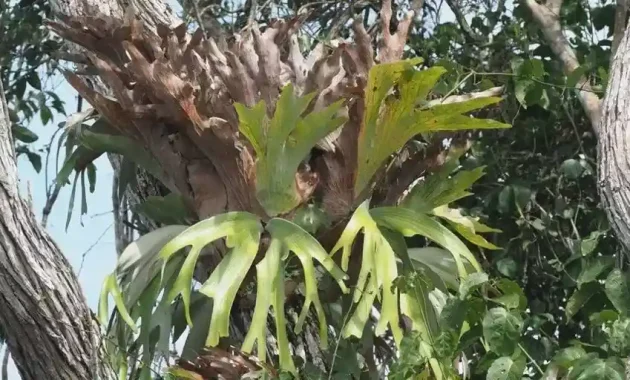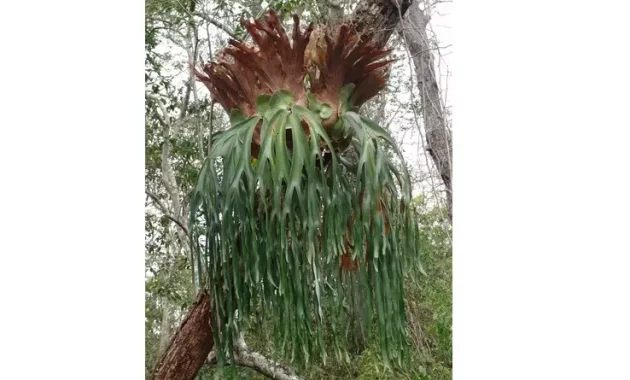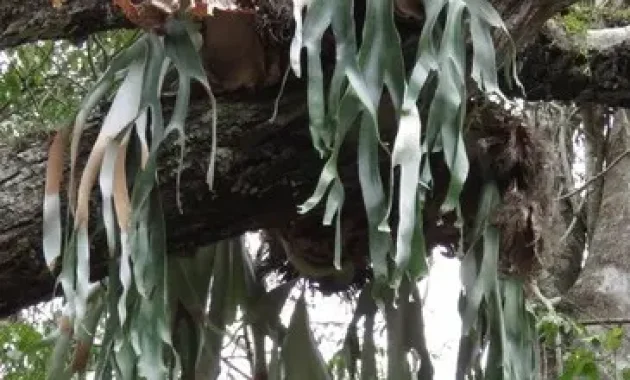Platycerium andinum, also known as American Staghorn, is a unique fern species native to Peru and Bolivia. It is the only staghorn naturally grown in the Americas and is recognized for its distinctive crown-like tops.
This fern primarily thrives in the Tropical Dry Forest of Peru, a threatened ecosystem estimated to be only 12,000 acres in size. Platycerium andinum propagates by growing new pups that encircle the host tree and prefers shade and moderate water, thriving on trees with rough bark. Despite being challenging to raise from spore, recent propagation efforts have produced hybrids.
The age of Platycerium andinum can be determined by the number of shield frond layers and the size of the ring. Unfortunately, the habitat of Platycerium andinum is under risk due to deforestation for farmland conversion.
Understanding and preserving this unique fern species is crucial for the conservation of its habitat and biodiversity.
Key Takeaways
- Platycerium andinum is the only staghorn naturally grown in the Americas.
- Platycerium andinum is recognized as the most natural cultivar known for this species.
- The fern grows new shield fronds once a year in the winter, which are thick and have a bowl-like shape.
- Platycerium andinum is considered one of the more difficult Platycerium to raise from spore.
What is Platycerium andinum?
Platycerium andinum, known as the American Staghorn, is a species of fern native to Peru and Bolivia that is recognized for its distinctive crown-like tops and tall slender structure.
This fern has several uses and benefits. Its unique appearance makes it a popular choice for ornamental purposes, and it is often grown as a decorative plant in gardens and greenhouses.

Additionally, Platycerium andinum plays a significant role in conservation efforts. The forest where this fern is found, called the Tropical Dry Forest of Peru, is under threat of deforestation for agricultural purposes. Efforts are being made to conserve and protect this endangered habitat, as it is estimated to be only 12,000 acres in size.
By preserving Platycerium andinum and its natural habitat, we can contribute to the conservation of biodiversity and the protection of this unique species.
Characteristics and Habitat
The American Staghorn fern, native to Peru and Bolivia, is primarily found in the Tropical Dry Forest of Peru, an endangered ecosystem that covers an estimated area of only 12,000 acres.
This fern exhibits several adaptations and survival strategies that enable it to thrive in its habitat. The Platycerium andinum has tall, slender fronds with distinctive crown-like tops. It grows new shield fronds once a year in the winter, which are thick and have a bowl-like shape.
The fern prefers shade and moderate water, and it grows best on trees with rough bark like the quinilla tree. However, it can also be grown on plaques of wood.
Despite its adaptability, the American Staghorn fern faces several threats, including the potential destruction of its habitat for farming purposes. Conservation efforts are being made to protect this species and its fragile ecosystem, but the future survival of the Platycerium andinum remains uncertain.
Propagation and Care
Propagation and care of the American Staghorn fern involve providing the necessary conditions of shade, moderate water, and a suitable host tree or wooden plaque for optimal growth.

When it comes to propagating Platycerium andinum, it is considered one of the more difficult Platycerium to raise from spore. However, recent propagation efforts have produced hybrids with Platycerium andinum as one of the parents.
To ensure successful propagation, it is important to create a humid environment by misting the spores regularly. Additionally, maintaining a consistent temperature and using a well-draining soil mix are crucial.
When it comes to optimal growing conditions, Platycerium andinum prefers shade and moderate water. It thrives best on trees with rough bark, such as the quinilla tree, but can also be grown on wooden plaques.
Overall, providing these optimal conditions and following proper propagation techniques will result in the successful growth and care of the American Staghorn fern.
Frequently Asked Questions
How long does it take for a Platycerium andinum to reach maturity?
The growth rate of Platycerium andinum and the factors affecting its maturity depend on various factors such as environmental conditions, availability of resources, and individual plant characteristics. Further research is needed to determine the specific timeframe for P. andinum to reach maturity.
Can Platycerium andinum be grown indoors?
Platycerium andinum can be grown indoors with proper care. It requires moderate to bright indirect light, and should be placed near a window with filtered sunlight. Avoid direct sunlight as it can damage the fern.
Are there any known pests or diseases that commonly affect Platycerium andinum?
Common pests and diseases of Platycerium Andinum include aphids, scale insects, mealybugs, and fungal infections such as rhizome rot. To prevent these issues, maintain a clean and well-ventilated environment, regularly inspect the plant for pests, and provide appropriate water and light conditions. Infestations can be treated with insecticides or by removing affected fronds. Fungal infections can be prevented by avoiding overwatering and providing good drainage.
What is the significance of the close relationship between Platycerium andinum and Platycerium quadridichotomum?
The close relationship between Platycerium andinum and Platycerium quadridichotomum is significant as it suggests a shared evolutionary history and genetic similarity. This relationship can provide insights into the adaptation, distribution, and ecological interactions of both species. Additionally, it may aid in conservation efforts and understanding the factors influencing the growth rate of Platycerium andinum.
How can the age of a Platycerium andinum plant be determined based on its shield fronds and ring size?
The age of a Platycerium andinum plant can be determined by counting the number of shield frond layers and examining the size of the ring. Factors affecting growth rate include environmental conditions, such as light, water, and nutrient availability.


